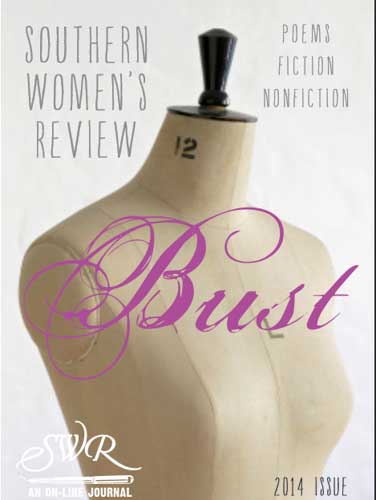Southern Women’s Review – 2014
This issue of Southern Women’s Review has a “Bust” theme and is full and broad in exciting and enriching literature including fiction, nonfiction, and poetry. As I was traveling at the time of reading this issue, I took special note of Kerry Madden-Lunsford’s piece in which the narrator is in China teaching English but is feeling isolated and very much an outsider. Although she wants to learn her own way into the culture, she can’t seem to and retreats back to English literature to find her own comfort.
This issue of Southern Women’s Review has a “Bust” theme and is full and broad in exciting and enriching literature including fiction, nonfiction, and poetry.
Irene Latham’s “Flight Pattern” uses a play on words relating to flight (tarmac, runway, land) to emphasize the final lines:
My love,
how many times
must you circle
when I would
have you land?
Kathleen Brewin Lewis uses the image of a hummingbird to show the speed of life, and how we are moving so fast through it that we cannot stop. As the hummingbird lands, “Everybody freeze, I whispered, / laying one finger across my lips. / But of course, we didn’t.” And I relate to her “Dogwood Winter” as a remembrance of this year’s long season.
As I was traveling at the time of reading this issue, I took special note of Kerry Madden-Lunsford’s piece in which the narrator is in China teaching English but is feeling isolated and very much an outsider. Although she wants to learn her own way into the culture, she can’t seem to and retreats back to English literature to find her own comfort.
Anne Bailey’s “Mortal” seemed to have some very strong feminist tones or images, but overall felt to be more about embracing the natural life rather than one we have come to accept with modern technology and shaved legs. But when it comes down to it, the love for her son allows her to change for him because that is the strongest connection she knows:
The hero’s journey requires adversity before the hero can emerge just as the human body is designed for a traumatic birth process. The infant is pushed from the mother. The child is forcibly expelled from the mother. This is the process that begins each life. As Edward’s mother, I came to appreciate the difference in our methods of establishing authentic presence. I pushed against authority and social standards while Edward joined that great social equalizer: football. We each discovered the corporeal voice of our experience, and in doing so inched our way forward on the spiritual path.
The theme of “Bust” seems to be only loosely connecting, with just a scattering of pieces throughout that relate (useful as the theme doesn’t feel overbearing). The piece I thought best fit was Gail Peck’s poem “32-B” which illuminates the power breasts have in shaping a young girl’s image of herself and her role in life:
I have what the boys desire to touch,
what the girls are dreaming of,
. . . . . . . . . . . . . . . . . . . . . . . .
fumbling until I take care of the damn thing myself,
and the world falls into their hands,
and my nipples become erect, and I am pitched
forward into the sexuality I’ve been warned against,
If you give in he won’t . . ., and I am in control
though spinning under the weight.
Cindy Small’s “Love Your Bosom; It’s a Holy Thing” also fit as it animatingly described a grandmother who owns a lingerie shop in New Orleans: “Instead of stirring matzo ball soup laden with chicken fat at home, she sold Tra La La panties.” I fell in love with the character, but there didn’t seem to be much story. I would have loved to see this turned into a long piece in which we could see the grandmother interact in a conflict.
Some pieces in this selection were not as strong and a few pieces had glaring editorial errors that were a bit distracting, but overall, it was a great read. And there is plenty more I’d recommend, especially Mary Galvin’s “Two Stones, Each with the Letter B” (incredibly sad but strong as it touches on death without hitting us in the face with it), and Carrie Spell’s “No One’s Daughter” (allows us to ask, where do we belong? What is home?).
[www.southernwomensreview.com]






